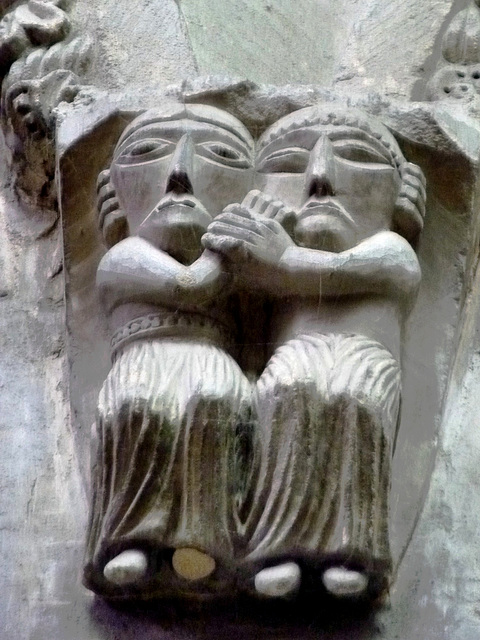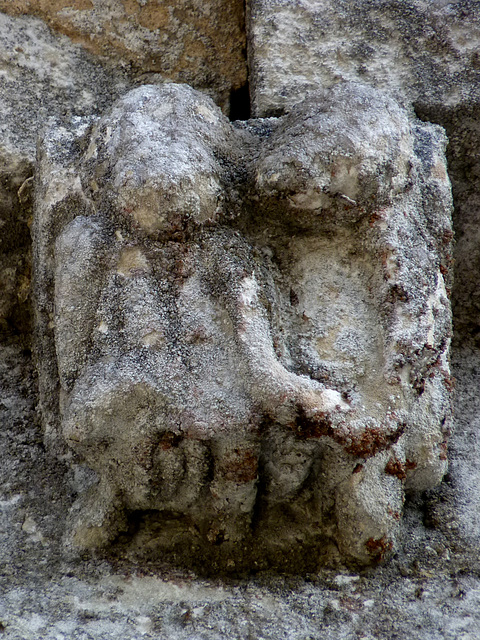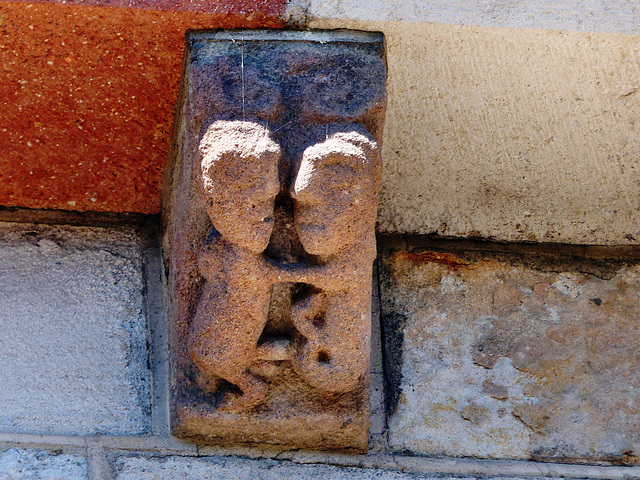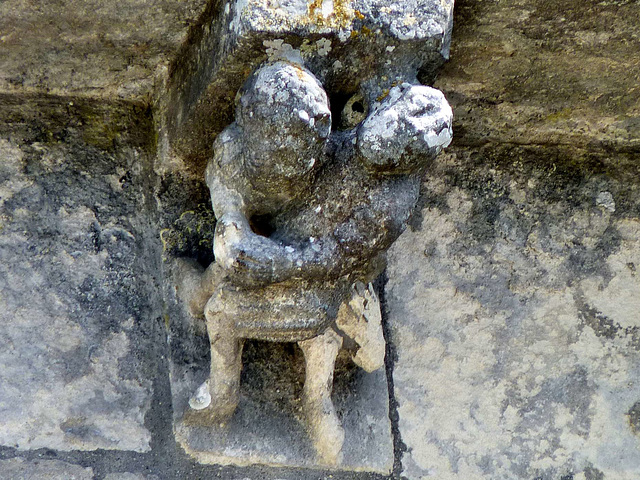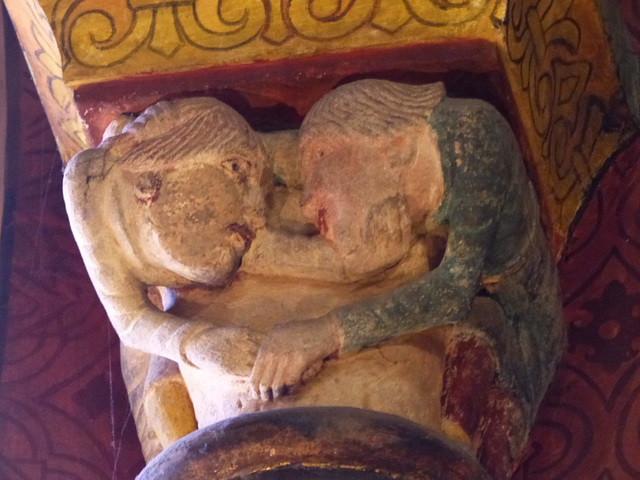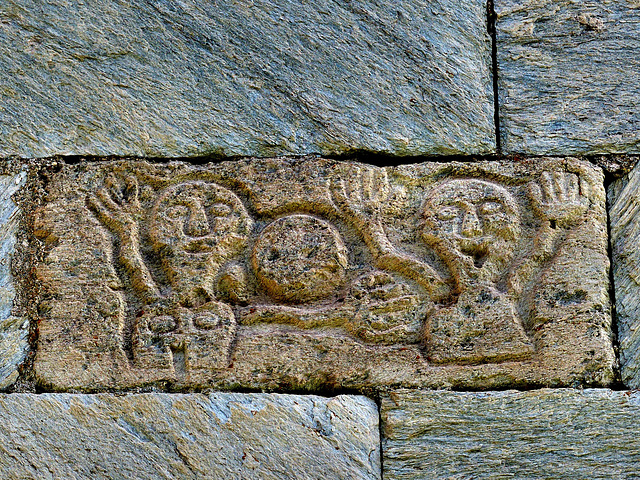
Medieval love couples
Bayeux - Cathedral
The cathedral "Notre-Dame de Bayeux" is the seat of the Bishop of Bayeux. It was the original home of the Bayeux Tapestry, that by now can be seen in the "Musée de la Tapisserie de Bayeux".
As seen on the Bayeux Tapestry, it was here that William the Bastard forced Harold Godwinson to take the oath, the breaking of which led to the Norman conquest of England. So William got "the Conqueror".
The preceding carolingian cathedral burnt down in 1047 and soon after the construction of the church seen today started. The cathedral got consecrated in 1077 by power-hungry Odon de Bayeux, who was William´s half-brother, well known warrior and bishop here. Of course, William was present during the consecration, as then he was Duke of Normandy and King of England.
At that time the building was not completed, the construction site was seriously damaged twice by fire during the 12th century and, when the walls of the nave were built (1180) the style changed from Romanesque to Gothic.
The cathedral got pillaged by Huguenots during the Wars of Religions, during the French Cathedral this was a "Temple de la Raison".
Renovation and restauration of the cathedral started mid 19th century under the direction of Eugène Viollet-le-Duc.
The structure of the nave is still Romanesque, so are many decorating carvings. This couple is known under the name "Les amoureux de Bayeux", "The Bayeux Lovers". They do not look really happy.
Vienne-en-Bessin - Saint-Pierre
When the erection of Saint-Pierre started within the 11th century, the place belonged to the "Jumièges Abbey", one of the most important abbeys in Northern France at that time.
The brickwork of oldest walls of Saint-Pierre are done in "opus spicatum" ("herringbone-pattern"), A long row of corbels is under the roof. There was a weathered, single female exhibitionist seen on the pervious uplöoad. Neighbouring to the lady is a nude couple.
Châteaumeillant - Saint-Genès
Saint-Genès, erected in the 11th and 12th century, was the church of the priory Saint-Etienne, dependent from the important Abbaye Notre-Dame in Déols. This abbey, now in ruins, had been founded in 917 and developed into one of the most powerful regional institutions. It was one of the first in the Cluniac network. Odo of Cluny (+ 942) was abbot of three monasteries: Cluny, Massy and Deols. This is important, as Saint-Genès has architectural parralells to Cluny II.
The building got severely damaged, when Louis VII (aka "Louis le Jeune", 1. husband of Eleanor of Aquitaine) burnt down the town in 1152 during a feud with Abbo II de Déols, a supporter of Henri Plantagenêt (aka Henry II, "Curtmantle", 2. husband of Eleanor of Aquitaine). In 1569 the Huguenots set fire here - and many restorations followed that. During the French Revolution the bell tower was destroyed and the church became a "Temple of Reason".
The walls of the nave are embellished with many sculpted capitals and corbels.
Some of the corbels under the roof are very rough.
An explicit work of art. A sexual act, created about 800 years, before the phrase "Make love, not war" was coined. Here is a couple - making love.
Milan - Basilica of Sant'Ambrogio
Milan is the city capital of the Lombardy and the second most populous city in Italy after Rome. Known during Roman times as "Mediolanum" it was the place, where in 313 Constantine I and Licinius met and "signed" the "Edict of Milan", giving Christianity a legal status within the Roman empire.
At the end of the Roman empire Milan was besieged by the Visigoths in 402, looted by the Huns in 452, and taken by the Ostrogoths in 539. Only 30 years later is belonged to the Kingdom of the Lombards, until in 774 Charlemagne defeated the Langobards and added Milan to the Carolingian empire. During Barbarossa´s (Frederik I) "Italian Campaigns" Milan was taken and destroyed to a great extent.
The "Basilica of Sant'Ambrogio" is much older and was not destroyed by Barbarossa´s troops. It is one of the most ancient churches in Milan, built by St. Ambrose in 379–386, outside the city of Milan on the site of a cemetery, where the martyrs of the Roman persecutions had been buried. The first name of the church was "Basilica Martyrum".
Ambrose, born into a noble family about 340 in (present-day) Trier (Germany), was governor of Liguria and Emilia for two years before he became the Bishop of Milan in 374 by popular acclamation. He was a staunch opponent of Arianism.
Only very few traces of the first church can still be found, as in the centuries after its construction, the basilica underwent numerous restorations and reconstructions. The current Romanesque church, mostly built in brickwork, was begun around 1080.
In 789, a Benedictine monastery was established here. The canons of the basilica, however, retained their own community. So two separate communities shared the basilica. In the 11th century, the canons adopted orders and became Canons Regular. From then on two separate monastic orders following different rules lived in the basilica. The canons were in the northern building, the cloister of the canons, while the monks were in the two southern buildings.
The two towers symbolize the division in the basilica. The 9th century Torre dei Monaci ("Tower of the Monks") tower was used by the monks. However, the canons did not have a bell tower and were not allowed to ring bells until they finished the Canons' bell tower in the 12th Century. This tower got two additional levels in 1889.
In 1943 the basilica got severely damaged by bombings. It took a decade to rebuilt and reconstruct the church.
The ambo stands on the left side of the nave. From here the monks and canons read the Gospel. The ambo, supported by nine slender ancient columns, was built over a 4th century sarcophagus, known as "Stilicho's Sepulchre", between 1130 and 1143. When the roof of the basilica collapsed in 1196, the ambo got severely damaged, but it got rebuilt already in 1201.
Between the ambo and the sarcophagus are some semicircular lunettes. They again differ style and in icons.
Couples can often be found in medieval art, but "love-couples", like this one, are pretty rare. Here both partners "float" doing a handshake, the other hand rests on the partner's shoulder.
Pérignac - Saint-Pierre
Saint-Pierre of today is a fortified church dating back to the 12th century. It replaced a small chapel, that existed here since 989.
The Romanesque facade got remodeled a couple of times over the centuries, but there are still many great carvings and sculptures.
One of the corbels has this nice love couple.
Migron – Saint-Nazaire
Saint-Nazaire was erected in the 12th century. The church has a very elaborate southern portal (prev. upl.). The geometrical design of the archivolts is typical for the "style saintongeais". Above the archivolts are some interesting corbels.
A love couple. She sits on his lap.
Brive-la-Gaillarde - Collégiale Saint-Martin
Brive´s parish church is a former collegiate church. The large church was erected in the 12th/13th century, where already Gregory of Tours mentions a church. This was built over the tomb of missionary "Saint Martin l'Espagnol" (aka "Saint Martin den Brive") at the end of the fifth century. Legends tell, that he was a disciple of Saint Martin of Tour.
For the first two centries the collegiate, founded end of the 11th century, prospered, supported by the Bishops of Limoge, but it entered financial difficulties later. The cloister of the collegiate was destroyed in 1764, after the Augustin canons living here, joined the Priory of Port-Dieu. After the Revolution the the conventual buildings were bought by City and demolished in 1835.
Many capitals line nave.
School reunion. "Is this really you?"
Vomécourt-sur-Madon - Saint-Martin
Not much is known about this church. Some scholars date the building mid 11th, most mid 12th century. It may have been built by the Knights Templar, but there is no document about it. It is a small Romanesque basilica, erected on a "Latin Cross" blueprint. Within the 19th century the church was modified. There are larger windows now and a roof, that now stretches over nave and the two aisles.
This seems a little "strange". There is a grimacing huge man, who is naked. His testicles seem to hang down to his knees. On the right a kissing couple. Man on the left, woman (long skirt) on the right. Does the naked hulk stand for (sinful) lust, that may arouse, when the couple continues?
Canari - Santa Maria Assunta
The island of Corsica is one of the 18 regions of France. It was colonized the Carthaginians, the Greeks, the Etruscans and the Romans. After the Roman empire collapsed, Corsica got invaded by the Vandals and the Ostrogoths. For a short while the island belonged to the Byzantine Empire, then the Franks granted the island to the Pope, in the early 11th century Pisa and Genoa together freed the island from the threat of Arab invasion. The island came under the influence of the Republic of Pisa, later it belonged to Genua for centuries. In 1755 after a long fight for independence from Genoa the independent Corsican Republic was proclaimed, but in 1769, when the island was conquered by France. As the areas near the coast over centuries have been threatened by attacks and raids of pirates many old hamlets and dwellings are wide inland, high in the mountains. So most of the old churches are in the mountains and some of them are hard to find.
Santa Maria Assunta is located in the hamlet Pieve, belonging to Canari. It was a single nave church (17m x 8.25m), erected in Pisan style, that was first mentioned in 1124. Probably a predessening church existed, as some carved stones are dated to the 10th century. They got reused here.
The church got enlarged and remodeled in the 17th century, when lateral chapels were added. Along the outer walls of the nave are medaillons and corbels in that rough style, that is typical for Corsica.This large carving is dated to an older building (10th c.). What is depicted here? A love couple? A nude female reaches out for a male (without legs!)? What does the right (male?) person hold? And is the full moon between them?
Jump to top
RSS feed- Latest items - Subscribe to the latest items added to this album
- ipernity © 2007-2025
- Help & Contact
|
Club news
|
About ipernity
|
History |
ipernity Club & Prices |
Guide of good conduct
Donate | Group guidelines | Privacy policy | Terms of use | Statutes | In memoria -
Facebook
X

